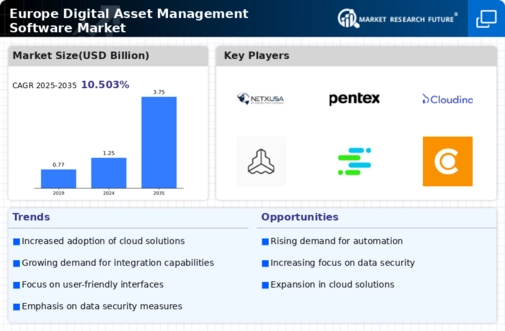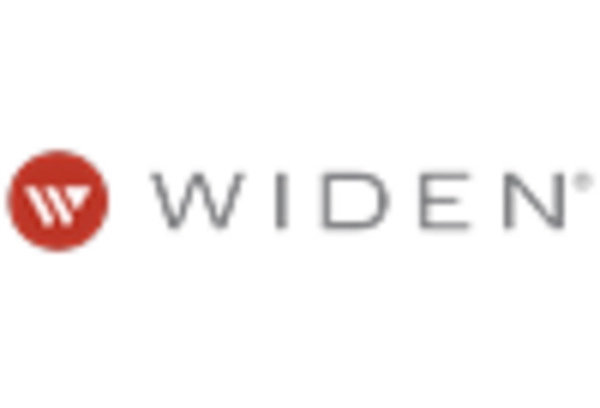Growing Importance of Brand Consistency
In the digital asset-management-software market in Europe, the growing importance of brand consistency is emerging as a key driver. As companies expand their digital presence, maintaining a cohesive brand image across various platforms becomes essential. This need is likely to propel market growth by approximately 10% in the next few years, as organizations seek solutions that facilitate the management of brand assets effectively. Digital asset management systems enable businesses to centralize their branding materials, ensuring that all stakeholders have access to the latest versions of logos, images, and marketing collateral. This centralization not only streamlines workflows but also enhances collaboration among teams, ultimately leading to a more unified brand representation. The emphasis on brand consistency reflects a broader trend towards strategic asset management, where companies aim to leverage their digital assets to strengthen their market position.
Regulatory Compliance and Data Security
In the context of the digital asset-management-software market in Europe, regulatory compliance and data security are becoming increasingly critical. With stringent regulations such as the General Data Protection Regulation (GDPR) in place, organizations are compelled to adopt solutions that ensure compliance while managing their digital assets. This necessity is likely to drive a market growth of around 12% in the coming years, as businesses prioritize secure asset management systems that protect sensitive information. The focus on data security not only mitigates risks associated with data breaches but also enhances customer trust. As companies navigate the complexities of compliance, the demand for software that offers robust security features, including encryption and access controls, is expected to rise. This trend underscores the importance of integrating compliance measures into digital asset management strategies.
Rising Demand for Digital Content Management
The digital asset-management-software market in Europe is experiencing a notable surge in demand for efficient digital content management solutions. As organizations increasingly rely on digital assets for marketing and branding, the need for robust management tools becomes paramount. In 2025, it is estimated that the market will grow by approximately 15%, driven by the necessity for streamlined workflows and enhanced collaboration. Companies are seeking solutions that not only store assets but also facilitate easy retrieval and sharing, thereby improving productivity. This trend indicates a shift towards comprehensive platforms that integrate various functionalities, catering to the diverse needs of businesses across sectors. The growing emphasis on digital marketing strategies further propels this demand, as firms aim to optimize their asset utilization and ensure brand consistency across multiple channels.
Increased Investment in Digital Transformation
The digital asset-management-software market in Europe is witnessing a significant boost due to increased investment in digital transformation initiatives. Organizations are recognizing the value of digital assets in enhancing operational efficiency and customer engagement. In 2025, it is projected that investments in digital transformation will reach €500 billion across various sectors, with a substantial portion allocated to asset management solutions. This trend suggests that businesses are not only adopting digital tools but are also seeking comprehensive systems that can integrate with existing technologies. The push for digital transformation is likely to drive innovation within the market, as software providers enhance their offerings to meet evolving business needs. Consequently, the demand for scalable and flexible digital asset management solutions is expected to rise, reflecting a broader shift towards a more digital-centric approach in organizational operations.
Emergence of Artificial Intelligence and Automation
The digital asset-management-software market in Europe is poised for transformation with the emergence of artificial intelligence (AI) and automation technologies. These advancements are expected to enhance the capabilities of digital asset management systems, making them more efficient and user-friendly. In 2025, it is anticipated that AI-driven solutions will account for a significant share of the market, potentially increasing by 20% as organizations seek to automate repetitive tasks and improve asset categorization. The integration of AI allows for smarter asset retrieval and personalized user experiences, which are becoming increasingly important in a competitive landscape. This trend indicates a shift towards more intelligent systems that not only manage assets but also provide insights and analytics to inform decision-making. As businesses embrace these technologies, the demand for innovative digital asset management solutions is likely to grow, reflecting a broader trend towards automation in various sectors.
















Leave a Comment